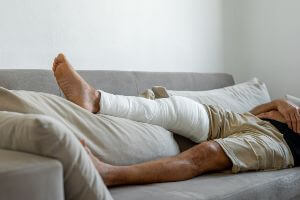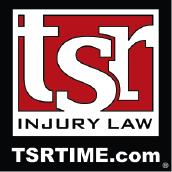Why Leg Pain Following a Minnesota Crash Could Be a Sign of a Leg Injury
 Car crashes can cause devastating injuries to your legs, ankles and feet. Severe leg injuries can also make it difficult to walk and can often limit your ability to complete everyday tasks, both at home and in the workplace.
Car crashes can cause devastating injuries to your legs, ankles and feet. Severe leg injuries can also make it difficult to walk and can often limit your ability to complete everyday tasks, both at home and in the workplace.
If you experience leg pain, instability, numbness or any other unusual symptoms in the hours and days after the collision, it is important to seek medical care right away as you may have suffered from one of the leg injuries detailed below.
TSR Injury Law has helped many victims, including those who suffered leg pain caused by debilitating car crash injuries. Our firm has obtained more than $1 billion for the injured in Minnesota.
The Bloomington-based car accident lawyers at our firm operate on contingency, which means we charge no fees unless we win your case.
Call today to schedule your free consultation: (612) TSR-TIME.
How Your Legs Could Get Injured in a Crash
There are five regions in your legs. Each part works in conjunction with the others to allow you to stand and walk. Damage to even one part can cause significant impairment.
- Upper legs or thighs –The bone inside the thigh is the femur. There are three hamstrings, five adductors, and four quadriceps. There are also the pectineus and sartorius muscles. While an injury to the femur is the most severe upper leg injury from a car crash, damage to the muscles surrounding it can also be serious. Injury to your adductors could potentially affect your balance, while an injury to the pectineus muscles could affect pelvic stability.
- Lower legs (calves) – The two bones inside the lower leg are the shin bone, also called the tibia, and the calf bone, also called the fibula. Nerves, muscles and tendons, like the Achilles tendon, connect the lower leg to the ankle and is essential for bearing weight. Any severe damage caused to this region is likely to affect your ability to walk, stand, run and jump.
- Knees – The largest joints in your body are your knees. Unfortunately, these joints are also the easiest ones to injure. There are many components to the knee, such as the patella, cartilage, menisci, ligaments, 14 bursa and numerous tendons. Damage to any one of these components can be debilitating and make it harder to walk or perform everyday activities.
- Ankles – The ankle consists of a bone that joins the tibia and fibula in your lower leg. Your medial and lateral ligaments help to keep your ankles stable. A twist, sprain or break in the ankle can have devastating consequences for your mobility.
- Feet – Your feet have numerous bones, muscles, ligaments and tendons all working together to help you maintain balance. Just one broken bone or a strain on a few muscles, ligaments or tendons can make it harder to maintain balance.
Oftentimes, leg injuries are the result of a leg getting pinned between two things in the car, or your leg striking something, such as the steering wheel or under the dashboard. A side-impact collision could also cause the side door to cave in, potentially causing you to strike your knee as well as your upper and lower leg. Leg injuries are particularly common in front-impact collisions.
Pain and Other Symptoms of a Leg Injury From a Car Crash
Crash victims are strongly encouraged to investigate pain and other symptoms in their legs as quickly as possible. Each injury is different, with some victims experiencing vastly different pain than others. While there are some leg injury victims who may be mildly uncomfortable, others may experience throbbing or shooting pain in various regions of their legs.
Leg injury symptoms to watch for include:
- Burning pain that moves up and down your legs: It is important to seek treatment, especially if the pain is located in your legs that were hurt during the crash.
- Sharp, throbbing pain, particularly when you put weight on the leg: Not getting treatment right away and continuing to put weight on the injured leg could cause further damage as a fractured bone may start to heal incorrectly causing a greater problem.
- Instability when standing or walking: If you feel weakness or pain, it could be due to ligament damage, a broken bone in your leg, or even a disc injury in your back.
- Clicking or popping noises when you move your knee or ankle: This may indicate joint damage.
- Numbness or feeling of pins and needles: This could indicate you sustained nerve damage in your legs. However, you may also have sustained a back/spinal cord injury that radiates into the legs.
- Stiffness in your legs: This may indicate muscle strain or more severe joint damage. The initial stiffness from a crash usually dissipates after a few days. Ongoing stiffness may indicate a more severe injury.
If you notice these and other symptoms following the crash, you should go to the hospital right away. Waiting to seek treatment allows the pain to get worse and could also mean a longer recovery. There may also be a greater potential for long-term or chronic symptoms to develop.
How Long Can It Take for Injury Symptoms to Appear?
Most vehicle crash injuries make themselves known immediately. Fractures, blood loss or excruciating pain will obviously be known right away. However, there are times when symptoms are delayed. For instance, you may experience delayed leg pain after a car crash.
If your leg gets punctured in a crash, you may consider it to be a minor wound and not seek treatment. However, over the next several days and weeks, you could end up with an infection. When infections are left untreated, they can cause damage to nerves and organs. In extreme cases, an untreated infection in your leg may result in amputation.
If you hurt your knee in the crash, it might not seem that bad at first and you may think the pain will go away on its own. However, knee pain could indicate a torn ligament and by continuing to walk around on your leg, you could cause further injury and lengthen your recovery time.
How Do You Know if a Leg Injury is Serious?
If your symptoms do not improve after a day or two, or they get worse, you likely suffered a significant injury. If you experience trouble walking, putting weight on one of your legs, or feel prolonged stiffness, you should seek medical treatment right away.
7 Types of Leg Injuries That Could Happen in a Collision
There are numerous leg injuries that could occur in a car crash. Below, we discuss several of the most serious car crash leg injuries:
- Fracture of your thigh bone – This is the longest, thickest and strongest bone in your body. It is not going to fracture unless a tremendous amount of force is applied. That is why recovering from a femur fracture often takes so much time, often six months or more. Because of this, doctors often need to perform surgery to repair this type of break and may need to insert a permanent metal rod in the middle of the thigh bone to assist healing.
- Broken fibula or tibia – Often these injuries happen when part of the leg gets trapped between things in the car, like the floor, steering wheel or dashboard.
- Damage to your anterior cruciate ligament (ACL) – A tearing of your ACL is painful, and victims often cannot put any weight on the injured leg while it heals.
- Damage to the sciatic nerve – If your spine gets misaligned during the impact, your sciatic nerve can get pinched. If this happens you could experience everything from numbness in your extremities to shooting pain down your leg.
- Bursitis in the knee – Your knee has cushiony sacs that are called bursae. These sacs act as padding for your muscles, bones and tendons in your knees. If one of these sacs becomes inflamed, you could experience painful swelling in your knee and other problems with the joint.
- Tear of your meniscus – Twisting of the cartilage in your knee could result in a tear of your meniscus. This can cause stiffness and pain in your knee, particularly when standing or walking. This injury can occur by slamming on the brakes at impact and twisting you leg.
- Broken feet, ankles or pelvis – There are numerous bones in your feet, ankles and pelvis. Any one of these bones has the potential to break, which can lead to devastating consequences.
Medical Treatment For Leg Injuries After a Car Crash
There are multiple steps involved in treating a leg injury. While each injury is unique, treatment is often similar. For some people, treatment may take longer, based on factors like:
- Severity of the injury
- Response to treatment
- Age
- Overall health
- Complications, including complications during surgery, such as an infection
How Are Broken Leg Bones Treated?
A broken bone needs to be set and immobilized to allow it to heal correctly. Immobilization is done through the use of a brace or cast. As discussed above with femur breaks, doctors may need to insert a rod to bring broken bones back together.
Patients may also be prescribed anti-inflammatory medications to reduce swelling while other patients may require corticosteroid injections.
How are Leg Ligament Injuries Treated?
Ice and elevation of the injured part of the leg, compression with an elastic bandage and limited activity is a typical treatment plan for ligament damage. In some cases, surgery may be needed.
How Are Leg Nerve Injuries Treated?
Treatment for a nerve injury may vary by patient, depending on the severity of the damage. Some of the potential treatment options could include:
- Decompression of nerves
- Electrical stimulation
- Corticosteroids
- Topical ointments
- Medications for pain management
Sometimes, doctors may recommend peripheral nerve surgery. This may be accompanied by physical therapy that is meant to improve stability and strength in your leg.
How Do Doctors Treat Injuries to Tendons in Your Legs?
Treatment of this injury is much like treatment for a bone break or ligament injury. Treatment may include:
- Cold compression of the area
- Pain medication
- Rest and limited activity
- Putting a brace on the area
- Using a cast to immobilize the area
- Performing surgery to fix damage to the tendon
Contact TSR Injury Law After a Minnesota Car Crash
Those who suffered leg injuries or any other serious injury in a car crash need experienced legal assistance.
The insurance company is going to fight hard to avoid paying you fair compensation, even though you have a debilitating injury. An experienced attorney helps to level the playing field, as he or she knows how to compile strong evidence and build a strong argument.
TSR Injury Law has been helping the injured in Minnesota since 1998 and we have a track record of success. Our services also come with no upfront fees.
We are ready to take your call: (612) TSR-TIME.



